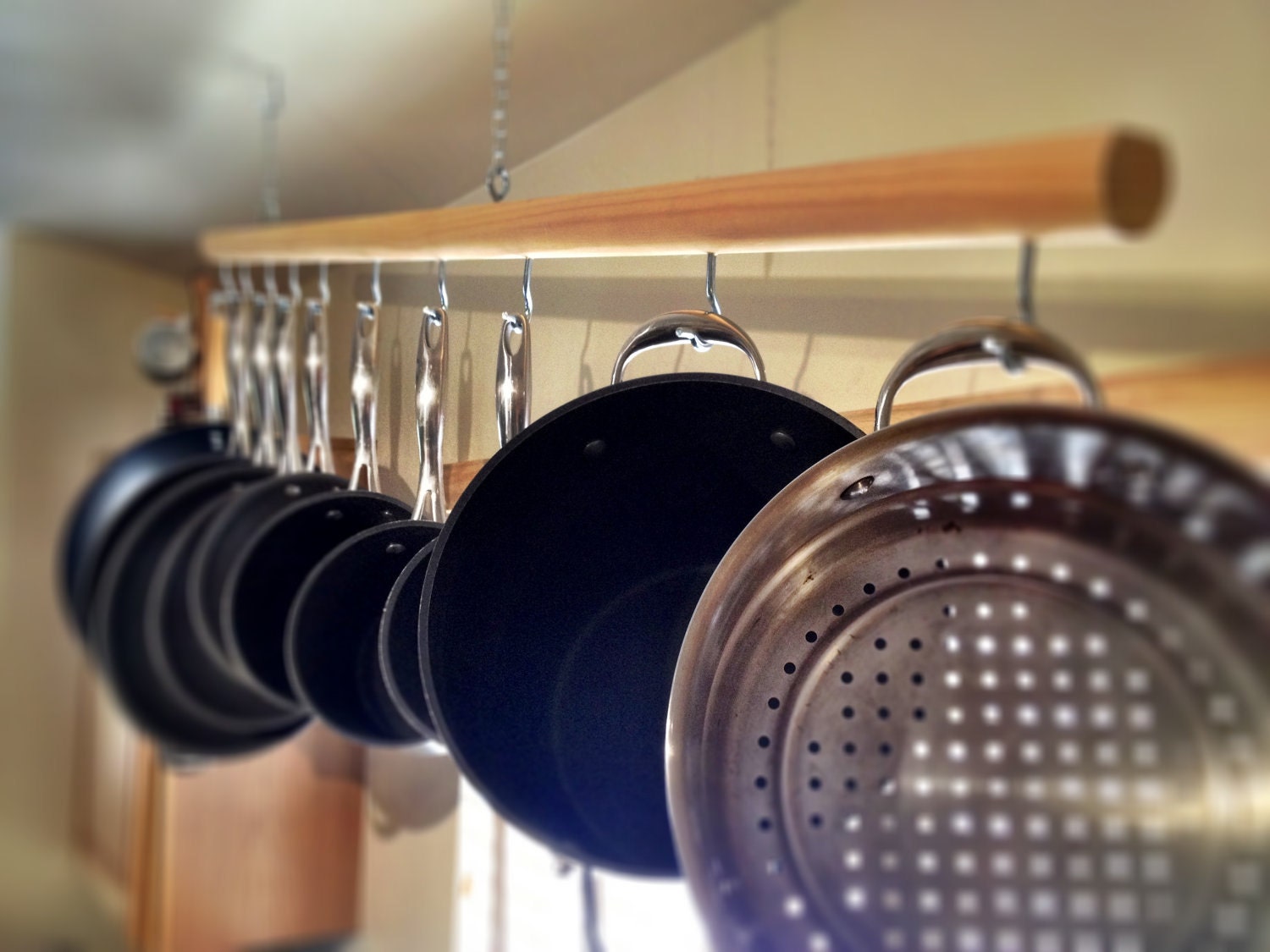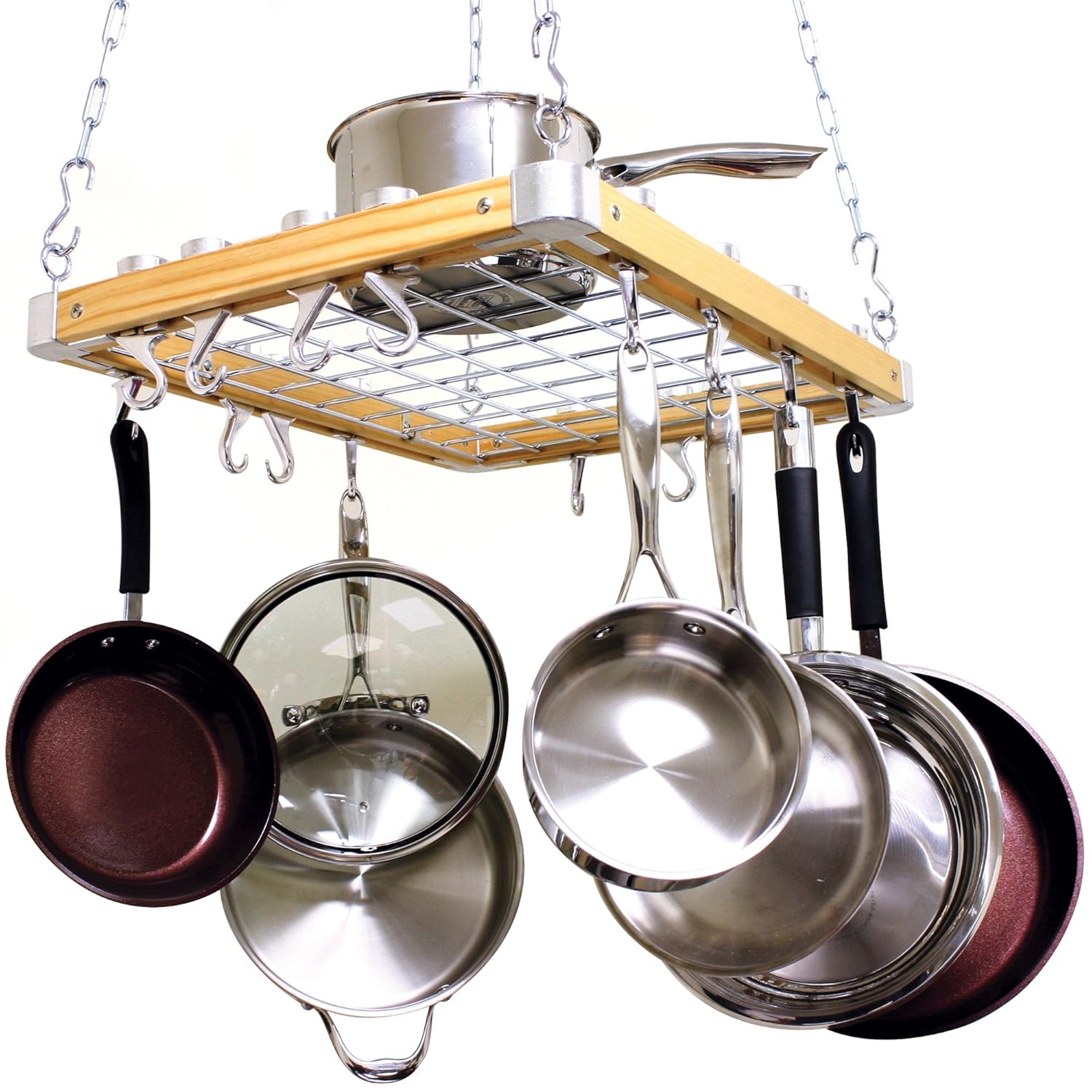Types of Kitchen Cabinet Pot Racks

Organizing your kitchen, a sacred space where nourishment for body and soul is prepared, can be a deeply fulfilling act. A well-organized kitchen reflects a mind at peace, a spirit ready to create. The humble pot rack, seemingly a simple tool, can become a potent symbol of this harmony, a testament to intention and mindful design. Choosing the right pot rack is a step towards cultivating this inner peace.
Kitchen cabinet pot rack – The selection of a pot rack transcends mere practicality; it’s an opportunity to infuse your kitchen with your personal style and enhance its energy. Different types of pot racks offer varying levels of convenience, aesthetics, and storage capacity. Understanding these differences is key to making a choice that resonates with your kitchen’s spirit and your own.
Under-Cabinet Pot Racks
Under-cabinet pot racks are designed to maximize vertical space, a precious commodity in many kitchens. They typically hang from the underside of your cabinets, utilizing otherwise unused space. Their compact design makes them ideal for smaller kitchens or those seeking a streamlined aesthetic.
Wall-Mounted Pot Racks
Wall-mounted pot racks offer a more visible and often more substantial storage solution. They are affixed directly to the wall, providing ample space for hanging pots, pans, and utensils. This style can become a striking focal point in the kitchen, adding a rustic charm or a modern flair depending on the design.
Freestanding Pot Racks, Kitchen cabinet pot rack
Freestanding pot racks stand independently, offering a versatile option for those without sufficient cabinet space or wall area. These racks often feature a larger capacity than under-cabinet or wall-mounted options, making them ideal for larger families or avid cooks. They can also serve as a decorative element, adding a unique touch to the kitchen’s design.
Comparison of Pot Rack Types
The following table provides a comparative overview of the three main types of kitchen cabinet pot racks, allowing for a more informed decision based on individual needs and preferences.
| Feature | Under-Cabinet | Wall-Mounted | Freestanding |
|---|---|---|---|
| Installation | Requires mounting to cabinet underside | Requires wall mounting | No installation required |
| Storage Capacity | Limited; suitable for smaller collections | Moderate to high; depends on rack size | High; often accommodates larger cookware |
| Ease of Access | Can be slightly less accessible than wall-mounted | Generally easy access | Easy access from all sides |
| Materials | Often metal (chrome, steel), sometimes wood | Metal (chrome, steel, wrought iron), wood | Metal (chrome, steel), wood, bamboo |
| Aesthetic Appeal | Sleek, space-saving | Rustic, modern, or industrial depending on design | Rustic, modern, or industrial, depending on design |
| Pros | Space-saving, clean look | Large capacity, visually striking | Large capacity, versatile placement |
| Cons | Limited capacity, potential for limited headroom | Requires wall space, potential for visual clutter if overloaded | Requires floor space, can be bulky |
Installing an Under-Cabinet Pot Rack
The installation of an under-cabinet pot rack, a simple yet profound act of kitchen organization, can be approached with mindfulness and precision. Each step contributes to the overall harmony of your space, reflecting your intention to create a functional and aesthetically pleasing environment.
- Measure and Mark: Carefully measure the space under your cabinet and mark the desired location for the rack’s mounting brackets. Ensure the rack will clear any obstructions like pipes or wiring.
- Drill Pilot Holes: Using a drill with a pilot bit slightly smaller than your mounting screws, drill pilot holes at the marked locations. This prevents the wood from splitting and ensures a clean installation.
- Attach Brackets: Securely attach the mounting brackets to the underside of the cabinet using the provided screws. Ensure the brackets are level and firmly attached.
- Hang the Rack: Carefully hang the pot rack onto the installed brackets. Ensure it is securely and evenly balanced.
- Test and Adjust: Test the rack’s stability by gently hanging a few pots. Make any necessary adjustments to ensure a secure and functional installation.
Materials and Design Considerations for Kitchen Cabinet Pot Racks

Choosing a kitchen cabinet pot rack is a journey of both practicality and aesthetic harmony. It’s about finding a balance between functionality, durability, and the overall visual appeal that enhances your sacred space—your kitchen. The materials and design elements you select will not only impact the longevity of your rack but also contribute to the soul of your culinary haven.
Material Comparison: Wood, Metal, and Bamboo
The essence of your pot rack lies in its material. Each option, wood, metal, and bamboo, carries its own unique energy, influencing both its lifespan and its visual contribution to your kitchen’s ambiance. The following table offers a comparative perspective:
| Material | Durability | Cost | Aesthetics |
|---|---|---|---|
| Wood (e.g., oak, maple) | High, with proper care; susceptible to moisture damage. | Medium to High | Warm, classic, adds a sense of rustic charm or sophisticated elegance depending on the wood type and finish. |
| Metal (e.g., steel, wrought iron) | Very high; resistant to moisture and damage, but can rust if not properly treated. | Medium to High (varies greatly depending on the metal and finish) | Modern, industrial, or sleek depending on the finish and design; can create a sense of strength and permanence. |
| Bamboo | Medium; relatively durable but susceptible to cracking or warping with excessive moisture. | Low to Medium | Natural, eco-friendly, brings a sense of calm and organic beauty; often integrates well with minimalist or Asian-inspired designs. |
Design Elements: Size, Finish, and Kitchen Harmony
The design of your pot rack is a reflection of your personal style and the overall energy of your kitchen. Size, finish, and compatibility with existing decor are all crucial considerations. A poorly chosen rack can disrupt the flow of your kitchen’s chi, while a well-chosen one enhances it.
For instance, a small, minimalist rack made of brushed stainless steel would complement a modern, sleek kitchen, creating a sense of streamlined efficiency. Conversely, a large, ornate wooden rack with a dark, rich finish might be the perfect centerpiece for a rustic or traditional kitchen, adding warmth and character. The visual weight and style of the rack should be in proportion to the overall size and design of your kitchen.
Weight Capacity: A Crucial Consideration
The weight your pot rack can safely hold is paramount. A rack that is overloaded risks damage, potentially leading to accidents. The material and design directly influence weight capacity.
For example, a sturdy metal rack with a robust construction can typically support a significantly higher weight than a bamboo rack of similar size. Similarly, a rack with widely spaced hooks will generally support heavier pots than one with closely spaced hooks. Always check the manufacturer’s specified weight limit before purchasing and avoid overloading your rack to maintain safety and integrity. Consider the weight of your heaviest pots and pans when making your selection, allowing for a comfortable safety margin.
Maintaining and Cleaning Kitchen Cabinet Pot Racks

The heart of the home, the kitchen, deserves reverence. Just as we nurture our bodies with wholesome food, so too must we care for the tools that prepare it. A well-maintained pot rack, a silent guardian of culinary implements, reflects not only cleanliness but also a mindful approach to our sacred space. The following guide offers practices to ensure the longevity and beauty of your pot rack, mirroring the enduring spirit of your culinary endeavors.
Cleaning Methods for Various Pot Rack Materials
Proper cleaning is paramount to preserving the integrity and aesthetic appeal of your pot rack. Different materials require different approaches. Neglecting this aspect can lead to premature wear and tear, diminishing the lifespan of your valuable kitchen companion.
- Stainless Steel: A simple wipe-down with a damp cloth and mild dish soap usually suffices. For stubborn stains, a paste of baking soda and water can work wonders. Avoid abrasive cleaners, which can scratch the surface. Regular polishing with a stainless steel cleaner will maintain its lustrous shine.
- Wood: Wood requires a gentler touch. Use a soft cloth dampened with mild soapy water, wiping along the grain. Avoid excessive moisture, which can damage the wood. Regularly apply a food-safe wood oil or beeswax to condition and protect the wood, enhancing its natural beauty and resilience.
- Wrought Iron: Wrought iron is susceptible to rust. Regularly wipe down with a damp cloth to remove dust and grease. Apply a light coat of rust preventative oil or wax periodically, especially in humid environments. For heavier rust, use a wire brush (carefully) and then apply a rust converter before oiling.
Addressing Common Pot Rack Problems
Even with diligent care, challenges may arise. Addressing these issues promptly prevents further damage and maintains the rack’s functionality.
- Rust: Rust is most common in iron and steel racks. Minor rust spots can often be removed with fine steel wool and a rust remover. For more extensive rust, consider professional restoration or replacement of the affected parts. Preventing rust through regular cleaning and application of protective coatings is key.
- Scratches: Scratches are inevitable, particularly on metal racks. For minor scratches on stainless steel, a metal polish can often minimize their appearance. On wood, a wood filler may be used to repair more significant scratches, followed by sanding and refinishing.
- Loose Hardware: Tighten loose screws or bolts regularly to ensure the stability and safety of your pot rack. If screws are stripped, consider replacing them with slightly larger screws or using wood glue and clamps for a stronger hold on wooden racks.
Organizing Pots and Pans Within a Pot Rack
Efficient organization maximizes space and minimizes clutter, enhancing the kitchen’s functionality and aesthetic appeal. This mindful approach reflects a harmonious balance between practicality and beauty.
- Assess Your Collection: Begin by evaluating your pots and pans. Discard or donate items you rarely use. This decluttering process creates space and simplifies organization.
- Prioritize Frequently Used Items: Place your most frequently used pots and pans in the most accessible locations within the rack. This ensures ease of access and reduces unnecessary searching.
- Size and Weight Distribution: Arrange heavier pots and pans towards the bottom of the rack to maintain balance and prevent tipping. Distribute weight evenly to avoid stress on the rack’s structure.
Consider the weight capacity of your specific pot rack.
- Grouping Similar Items: Group similar items together—for example, place all saucepans together, all frying pans together. This enhances visual appeal and makes it easier to locate specific items.
- Visual Appeal: While functionality is paramount, consider the visual aesthetic. Arrange items in a way that is pleasing to the eye. This transforms the pot rack from a mere storage solution into a decorative element within your kitchen.
